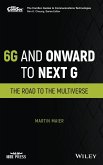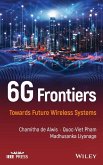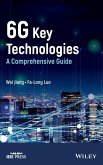Intelligent Reconfigurable Surfaces (IRS) for Prospective 6G Wireless Networks
Authoritative resource covering preliminary concepts and advanced concerns in the field of IRS and its role in 6G wireless systems
Intelligent Reconfigurable Surfaces (IRS) for Prospective 6G Wireless Networks provides an in-depth treatment of the fundamental physics behind reconfigurable metasurfaces, also known as intelligent reflecting surfaces (IRS), and outlines the research roadmap towards their development as a low-complexity and energy-efficient solution aimed at turning the wireless environment into a software-defined entity.
The text demonstrates IRS from different angles, including the underlying physics, hardware architecture, operating principles, and prototype designs. It enables readers to grasp the knowledge of the interplay of IRS and state-of-the-art technologies, examining the advantages, key principles, challenges, and potential use-cases. Practically, it equips readers with the fundamental knowledge of the operational principles of reconfigurable metasurfaces, resulting in its potential applications in various intelligent, autonomous future wireless communication technologies.
To aid in reader comprehension, around 50 figures, tables, illustrations, and photographs to comprehensively present the material are also included.
Edited by a team of highly qualified professionals in the field, sample topics covered are as follows:
_ Evolution of antenna arrays design, introducing the fundamental principles of antenna theory and reviewing the stages of development of the field;
_ Beamforming design for IRS-assisted communications, discussing optimal IRS configuration in conjunction with overviewing novel beamforming designs;
_ Reconfigurable metasurfaces from physics to applications, discussing the working principles of tunable/reconfigurable metasurfaces and their capabilities and functionalities;
_ IRS hardware architectures, detailing the general hardware architecture of IRS and features related to the IRS's main operational principle;
_ Wireless communication systems assisted by IRS, discussing channel characterization, system integration, and aspects related to the performance analysis and network optimization of state-of-the-art wireless applications.
For students and engineers in wireless communications, microwave engineering, and radio hardware and design, Intelligent Reconfigurable Surfaces (IRS) for Prospective 6G Wireless Networks serves as an invaluable resource on the subject and is a useful course accompaniment for general Antenna Theory, Microwave Engineering, Electromagnetics courses.
Authoritative resource covering preliminary concepts and advanced concerns in the field of IRS and its role in 6G wireless systems
Intelligent Reconfigurable Surfaces (IRS) for Prospective 6G Wireless Networks provides an in-depth treatment of the fundamental physics behind reconfigurable metasurfaces, also known as intelligent reflecting surfaces (IRS), and outlines the research roadmap towards their development as a low-complexity and energy-efficient solution aimed at turning the wireless environment into a software-defined entity.
The text demonstrates IRS from different angles, including the underlying physics, hardware architecture, operating principles, and prototype designs. It enables readers to grasp the knowledge of the interplay of IRS and state-of-the-art technologies, examining the advantages, key principles, challenges, and potential use-cases. Practically, it equips readers with the fundamental knowledge of the operational principles of reconfigurable metasurfaces, resulting in its potential applications in various intelligent, autonomous future wireless communication technologies.
To aid in reader comprehension, around 50 figures, tables, illustrations, and photographs to comprehensively present the material are also included.
Edited by a team of highly qualified professionals in the field, sample topics covered are as follows:
_ Evolution of antenna arrays design, introducing the fundamental principles of antenna theory and reviewing the stages of development of the field;
_ Beamforming design for IRS-assisted communications, discussing optimal IRS configuration in conjunction with overviewing novel beamforming designs;
_ Reconfigurable metasurfaces from physics to applications, discussing the working principles of tunable/reconfigurable metasurfaces and their capabilities and functionalities;
_ IRS hardware architectures, detailing the general hardware architecture of IRS and features related to the IRS's main operational principle;
_ Wireless communication systems assisted by IRS, discussing channel characterization, system integration, and aspects related to the performance analysis and network optimization of state-of-the-art wireless applications.
For students and engineers in wireless communications, microwave engineering, and radio hardware and design, Intelligent Reconfigurable Surfaces (IRS) for Prospective 6G Wireless Networks serves as an invaluable resource on the subject and is a useful course accompaniment for general Antenna Theory, Microwave Engineering, Electromagnetics courses.








